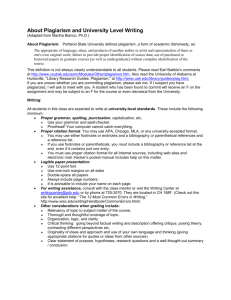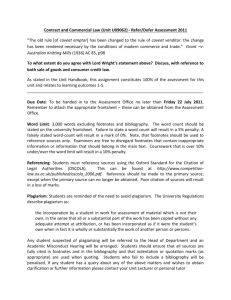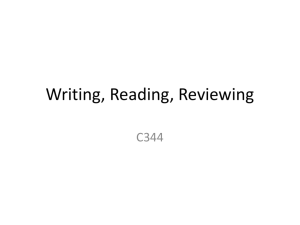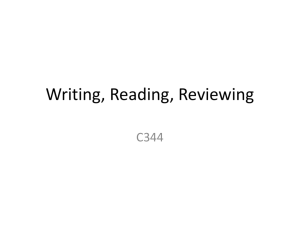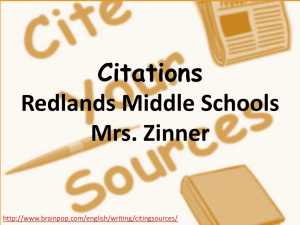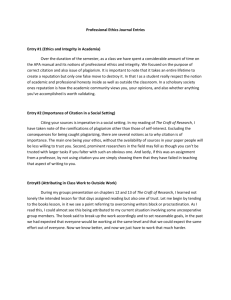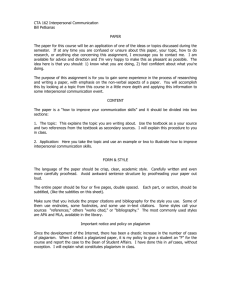Guidelines for the individual and group reports Cyrille Berger November 30, 2015
advertisement
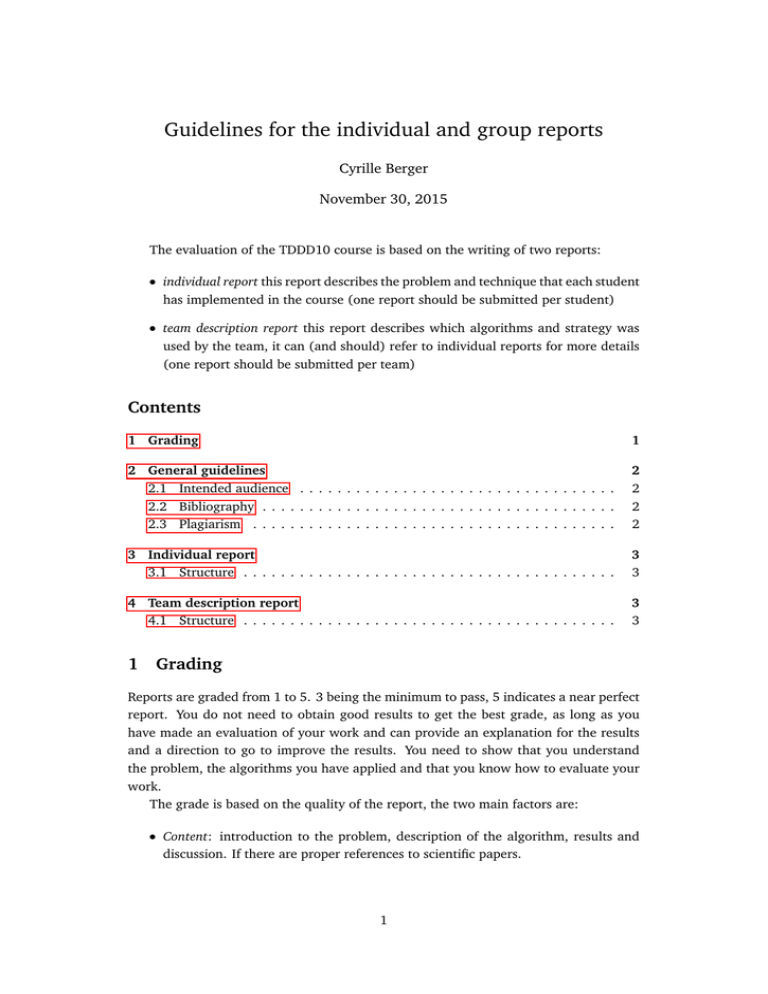
Guidelines for the individual and group reports Cyrille Berger November 30, 2015 The evaluation of the TDDD10 course is based on the writing of two reports: • individual report this report describes the problem and technique that each student has implemented in the course (one report should be submitted per student) • team description report this report describes which algorithms and strategy was used by the team, it can (and should) refer to individual reports for more details (one report should be submitted per team) Contents 1 Grading 1 2 General guidelines 2.1 Intended audience . . . . . . . . . . . . . . . . . . . . . . . . . . . . . . . . . . 2.2 Bibliography . . . . . . . . . . . . . . . . . . . . . . . . . . . . . . . . . . . . . . 2.3 Plagiarism . . . . . . . . . . . . . . . . . . . . . . . . . . . . . . . . . . . . . . . 2 2 2 2 3 Individual report 3.1 Structure . . . . . . . . . . . . . . . . . . . . . . . . . . . . . . . . . . . . . . . . 3 3 4 Team description report 4.1 Structure . . . . . . . . . . . . . . . . . . . . . . . . . . . . . . . . . . . . . . . . 3 3 1 Grading Reports are graded from 1 to 5. 3 being the minimum to pass, 5 indicates a near perfect report. You do not need to obtain good results to get the best grade, as long as you have made an evaluation of your work and can provide an explanation for the results and a direction to go to improve the results. You need to show that you understand the problem, the algorithms you have applied and that you know how to evaluate your work. The grade is based on the quality of the report, the two main factors are: • Content: introduction to the problem, description of the algorithm, results and discussion. If there are proper references to scientific papers. 1 • Clarity: if the report is easy to understand and pleasant to read. Do not hesitate to use a picture or a diagram to explain difficult concepts, a picture is worth a thousand words. When deciding the final grade, content is more important than clarity. But if the report is hard to read, it makes it more difficult for the examiner to understand the content. The reports should be 5-6 pages, but it is more important to make it possible for the reader to understand your report than to get the exact right number of pages. It is an art to write short, concise and to the point, so writing more than 6 pages is only positive if you fill it with relevant and well written content. 2 2.1 General guidelines Intended audience When writing a report, it is always important to know who is going to read it. In this case, the report should be understandable by any student who has attended the course, do not hesitate to ask your fellow students to read your report and give you some comments. 2.2 Bibliography When writing your reports it is important to refer to existing scientific publication. The scientific paper should be referenced in the document using a number (ie [1], [2]...), and the title, authors and source should be listed at the end of the document. When referencing a paper in your report, you should have a small description of what the reader can found in the article, for instance: “According to S. Tucker [1], the greedy task allocation algorithm give the best results with perfect world knowledge, but it was shown by C. Kelley in her thesis Task Allocation for a rescue team [2] to degrade quickly when the communication is unreliable.” Or: “The greedy task allocation algorithm is an algorithm that assign the most urgent tasks to each agents. In a first steps, it does [...], then [...]. More implementation details can be found in [1].” At the end of the report, in a bibliography section, you should have the list of references: [1] Greedy task Allocation, S. Tucker, R. Knipe and F. Myers, in The 16h International Conference on Multi-Agents Systems, 2001 [2] Task Allocation for a rescue team, C. Kelley, PhD Thesis, 2005 2.3 Plagiarism The normal rules regarding plagiarism should be followed, violation of the rules are considered to be cheating. In case of doubt, always ask your teacher. Both the individual and team reports should be your own work. It is allowed to re-use part of the individual report in the team report (such as figures). It is allowed to give a citation from a scientific paper, but you should in your report specify the author 2 of the citation, and you should only do it if the citation is of exceptional value to your work. 3 Individual report The individual report is a summary of the work that each student has accomplished during the course. 3.1 Structure The individual report should follow the IMRAD organization structure: • Introduction: describes the domain, the problem, what are the possible solutions and what is your hypothesis, why you think the solution you choose will give the best results (~1 page) • Methods: describes the techniques or algorithms that you have implemented (~2 pages), use figures when necessary, it is also best to stick to a mathematical description, but you can use pseudocode if you prefer, but be sure to explain each step of the algorithm • Results: give the results you obtained (~1-2 pages) • Discussion: did you get the results you expected? did it differs from the results you found in other scientific paper? why do you think they are different? And most importantly, what would you do next, to improve the results? (~1 pages) 4 Team description report The group report should describes which algorithms and strategies were chosen to implement the team. It should be in the range of 4 to 6 pages. It should be very similar in structure and content to team description of the official robocup rescue competition. 4.1 Structure This is only a suggestion of structure, you might use a different approach depending on how you have worked in your team: • Navigation and path planning • Communication • Police agents: exploration and task allocation • Fire brigades: exploration and task allocation • Ambulances: exploration and task allocation 3
